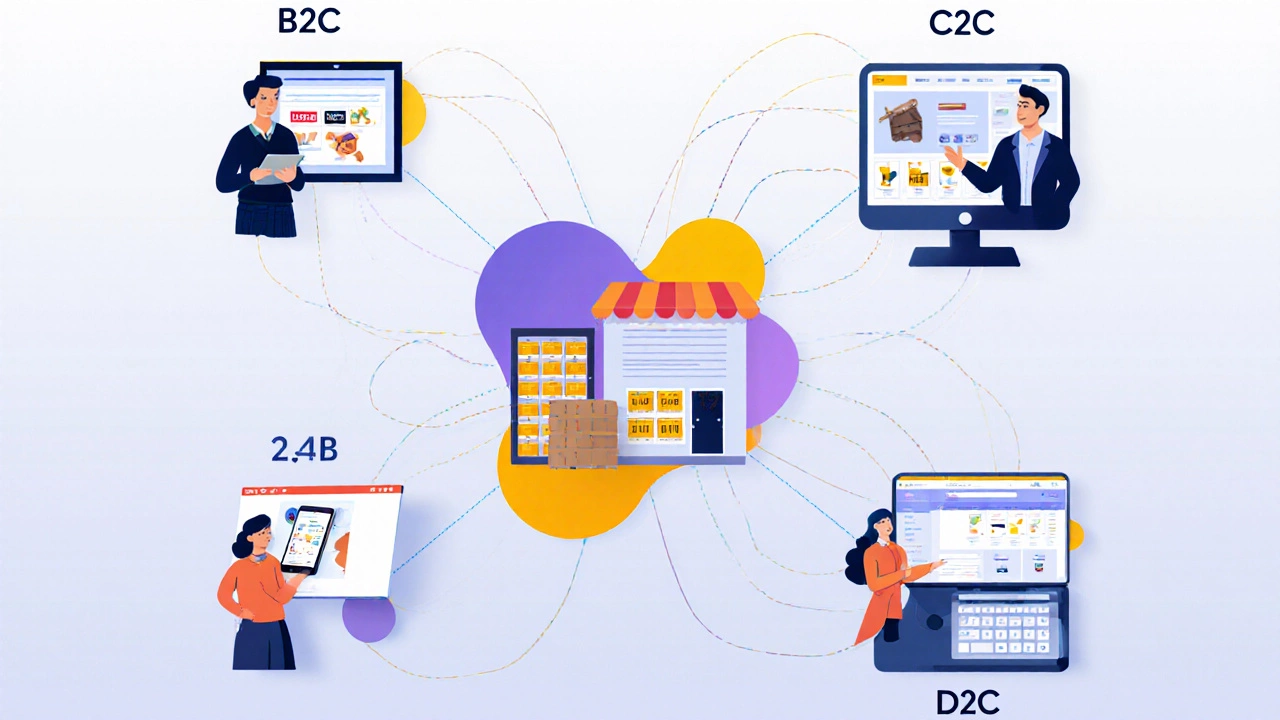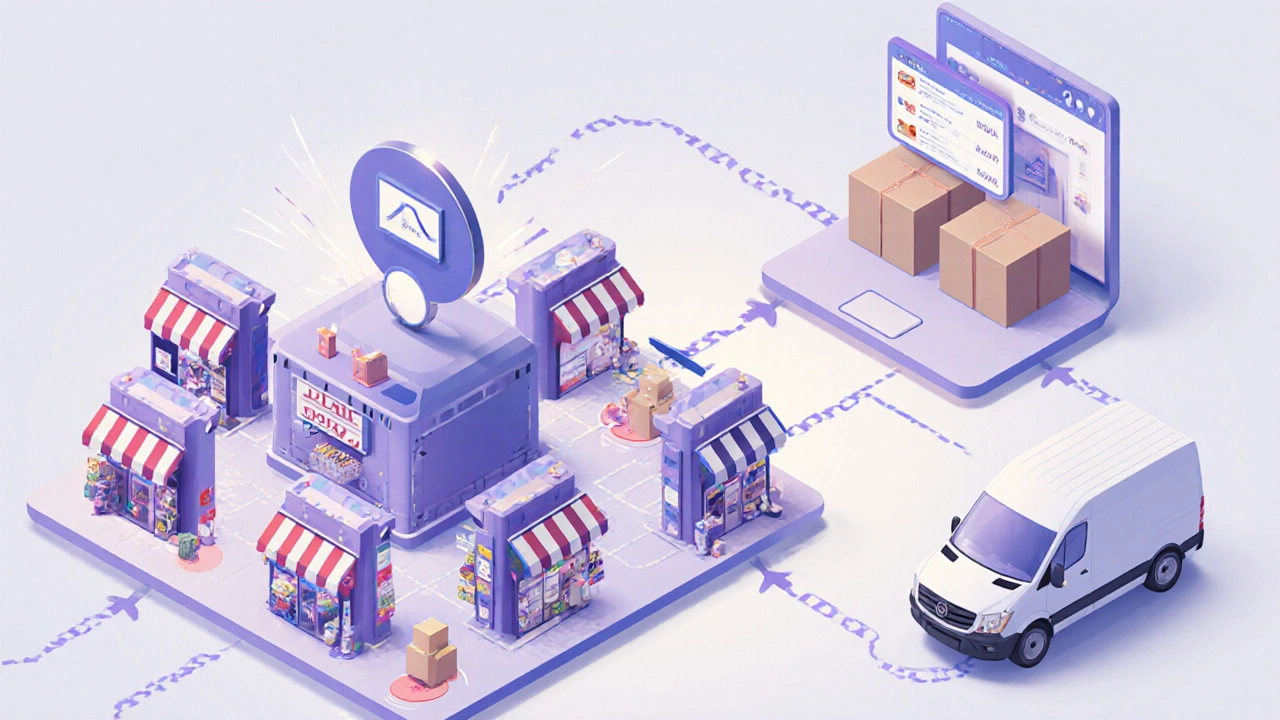E-commerce Business Model Selector
Select your business characteristics to determine the best e-commerce model for your situation.
Recommended E-commerce Model
Why this model works for you:
Ever wondered why you can buy a handmade necklace from an Instagram shop and a new TV from a global giant in a few clicks? That’s e‑commerce examples in action - a sprawling ecosystem where anyone can sell or buy online.
Key Takeaways
- e‑commerce covers several distinct business models: B2C, B2B, C2C, C2B and D2C.
- Each model has typical platforms and revenue strategies.
- Real‑world sites illustrate how the models work in practice.
- Niche approaches like marketplaces, subscription services and drop‑shipping expand the landscape.
- Choosing the right model depends on your product, audience and resources.
What is e‑commerce?
When we talk about e‑commerce is a digital buying and selling of goods or services over the internet, we’re describing a spectrum of activities that range from a sole‑proprietor posting a product on Instagram to multinational platforms handling millions of transactions daily.
Core Business Models
Below are the five classic models that make up the backbone of online commerce.
- B2C (business‑to‑consumer): Companies sell directly to end‑users. Think of Amazon or Shopify stores that market products to shoppers.
- B2B (business‑to‑business): One business supplies another. Platforms like Alibaba or Grainger specialize in bulk orders for enterprises.
- C2C (consumer‑to‑consumer): Individuals sell to each other, often via a third‑party marketplace. eBay and Depop are classic examples.
- C2B (consumer‑to‑business): Users offer products or services to companies. Think of freelance platforms like Upwork where freelancers bid for corporate projects.
- D2C (direct‑to‑consumer): Brands bypass retailers and sell straight to shoppers. Warby Parker, Glossier and Allbirds exemplify this model.

Real‑World Examples by Model
Seeing the models in action helps you picture where your own idea might fit.
| Model | Typical Platform | Live Example |
|---|---|---|
| B2C | Custom storefront (Shopify, WooCommerce) | Amazon, Best Buy |
| B2B | Wholesale portal (Magento, SAP Commerce) | Alibaba, Grainger |
| C2C | Marketplace (eBay, Depop) | eBay, Etsy |
| C2B | Freelance marketplace (Upwork, Fiverr) | Upwork, 99designs |
| D2C | Brand website (Shopify, Squarespace) | Warby Parker, Glossier |
Niche & Hybrid Models
Beyond the five pillars, several specialized approaches have gained traction.
- Marketplace (a platform that hosts multiple sellers): The site takes a commission on each sale. Etsy and Airbnb (for experiences) fit this mold.
- Subscription model (recurring billing for products or services): Companies ship curated boxes or grant access to digital content. Dollar Shave Club and Netflix illustrate the concept.
- Drop shipping (selling without holding inventory): The retailer forwards orders to a third‑party supplier who ships directly to the customer. Oberlo (used with Shopify) is a popular tool.

How to Pick the Right Model for Your Online Store
- Identify your target audience. Are you selling to everyday shoppers (B2C) or to other businesses (B2B)?
- Assess product complexity. High‑ticket, custom‑spec items often work better in B2B or D2C setups.
- Consider logistics. If you don’t want to manage inventory, explore drop shipping or marketplace hosting.
- Evaluate revenue goals. Subscription models generate predictable cash flow; commission‑based marketplaces scale with volume.
- Test and iterate. Start with a minimal viable storefront on Shopify or WooCommerce, gather data, then expand to hybrid models if needed.
Remember, many successful brands blend models - a D2C brand might also run a marketplace for third‑party accessories, or a B2B supplier may add a subscription box for sample kits.
Quick Checklist for Launching Your First e‑commerce Site
- Define your business model (B2C, B2B, etc.).
- Choose a platform - Shopify for speed, WooCommerce for WordPress flexibility, Magento for enterprise needs.
- Set up payment gateways (Stripe, PayPal).
- Plan logistics - inventory, drop shipping, or third‑party fulfillment.
- Implement SEO basics - keyword research, product schema, fast loading.
- Launch, monitor analytics, and refine.
What is the difference between B2C and D2C?
B2C (business‑to‑consumer) describes any company selling to shoppers, often through third‑party retailers or large marketplaces. D2C (direct‑to‑consumer) means the brand owns its storefront and ships straight to the customer, cutting out the middleman.
Can a single e‑commerce site combine multiple models?
Yes. Many sites run a core D2C shop while also hosting a marketplace for complementary products, or they add a subscription tier for recurring revenue.
Is drop shipping suitable for high‑ticket items?
It can work, but you need reliable suppliers and clear return policies. High‑ticket items often require better quality control, so many sellers reserve drop shipping for low‑margin, fast‑moving goods.
Which platform is best for a small B2B wholesale site?
Magento (Adobe Commerce) offers robust B2B features like tiered pricing and custom catalogs, though it requires more technical expertise. For a leaner setup, Shopify Plus with B2B apps can also serve well.
How does a subscription model affect cash flow?
Subscriptions create predictable, recurring revenue, smoothing out seasonal spikes. However, you must maintain product quality and service to keep churn low.
